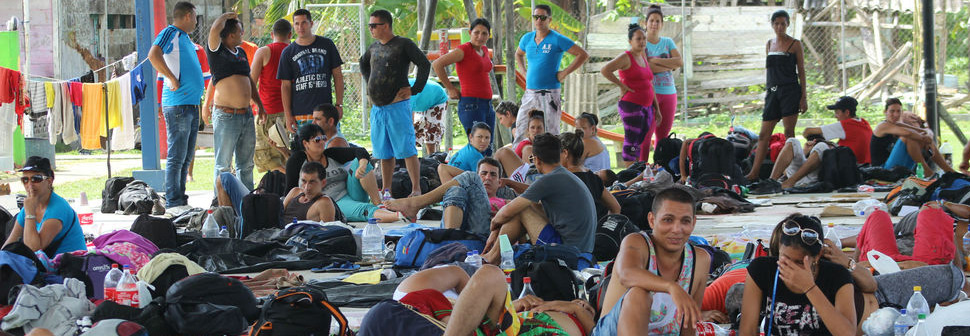As Colombia emerges from War, new challenges mount


In December 2016, Colombia formally brought to a close a 52-year civil war that resulted in the deaths of more than 220,000 people, the flight of more than 7.6 million within and beyond the country’s borders, and an incalculable cost to the economy and public well-being. Approved by Congress after four years of negotiations between the Colombian government and the left-wing rebel group known as the Revolutionary Armed Forces of Colombia (FARC), the historic peace deal ended the longest-running civil conflict in the Western Hemisphere, one that has taken a huge toll on Colombian society, most profoundly in the area of migration.
Violence-driven displacement in rural areas has given Colombia the dubious distinction of hosting the most internally displaced persons (IDPs) in the world, with 7.3 million individuals registered as of 2016—more than 15 percent of the national population. In addition, hundreds of thousands of Colombians are estimated to live abroad as refugees, primarily in neighboring countries. Ongoing violence by other guerrilla and paramilitary groups is making return difficult for these refugees.
Historically known for large-scale emigration, Colombia experienced little immigration during the 19th and 20th centuries as a result of conditions including political violence, recurring economic crises, excess labor, and poor infrastructure. Instead, millions of Colombians sought refuge abroad or emigrated in search of better opportunities during that period. Faced with a sizeable diaspora, the Andean country has slowly adopted a comprehensive migration system targeted at improving services for emigrants. In recent years Colombia has worked to attract highly skilled foreign labor, in line with an economic model that prioritizes foreign investment.
As the country enters a post-conflict phase and turns its focus to peace and stability, addressing the main causes of internal displacement and developing effective strategies to improve immigration services will be key. Colombia is also grappling with a number of international migration issues, including transiting flows of irregular migrants from beyond the continent and a humanitarian crisis in Venezuela. This country profile outlines the historical trends that have defined Colombia’s migration history and policy, and examines the current and future migration challenges facing a country unsteadily emerging from war.
New World Gateway
Considered a strategic gateway to South America, the area now encompassed by Colombia began experiencing migration from Mesoamerica as early as 14,000 BC, providing a passage for hunter-gatherers to gradually populate other parts of the continent in the pre-Columbian era. In the early 16th century, a leading indigenous group in the area called the Muisca became the inspiration for El Dorado, the gold-rush legend that would fuel immigration and Spanish conquest of the continent for centuries.
Spanish colonization proved to be a defining event in Colombian history. By the 17th century, 95 percent of the indigenous population had been killed off by settlers or newly introduced diseases. A major slave market emerged and Spanish colonists brought an estimated 120,000 African slaves. The vast majority of settlers were of Andalusian and Basque descent, as immigration of non-Spaniards was highly regulated. Otherwise, Colombia was not a recipient of large migratory flows between the 16th and 18th centuries.
Immigration to Colombia remained limited following its independence in 1819. Over the course of the 19th and 20th centuries, occasional migrant flows arrived from Syria, Lebanon, Palestine, Germany, Italy, Spain, France, and Japan, but Colombia did not experience the same large-scale immigration seen elsewhere in Latin America.
Syrian, Lebanese, and Palestinian immigrants first arrived in Colombia in the 1880s. An estimated 5,000 to 10,000 Middle Easterners settled between 1890 and 1930, making them the second-largest immigrant group. These communities transformed commerce and trade in Colombia and had significant political involvement in the first half of the 20th century. Although the flow of Arab-Christian immigrants decreased in the late 1900s, a large number of descendant communities remain active.
European immigration to Colombia increased between the mid-19th and mid-20th centuries. Two waves of Jewish immigrants settled in Colombia between 1830 and 1938, contributing significantly to regional financial sectors through trade and business. Germans arrived in the mid-1800s, and by the early 1900s were leading revitalization of the coffee, tobacco, and banking industries. After World War II, many European technicians and agricultural experts migrated to Colombia. Other immigrant communities that developed successful enterprises were the Spanish, French, Italians, and Americans, who settled in the capital of Bogotá for the most part, and the Japanese who settled in the Cauca Valley region.
Regional and hemispheric migration flows have prevailed in Colombia since the 1960s. Venezuela, the United States, and Ecuador have been the leading countries of origin for immigrants in recent years (see Figure 1). According to the United Nations, more than 133,000 immigrants lived in Colombia in 2015, representing 0.2 percent of the population of 47 million. A substantial number are returning migrants holding dual citizenship.
Relief web | Dayra Carvajal





